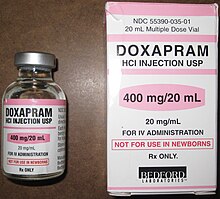Doxapram
 | |
| Clinical data | |
|---|---|
| Routes of administration | Intravenous |
| ATC code | |
| Legal status | |
| Legal status |
|
| Identifiers | |
| |
| CAS Number | |
| PubChem CID | |
| DrugBank | |
| ChemSpider | |
| UNII | |
| KEGG | |
| ChEBI | |
| ChEMBL | |
| CompTox Dashboard (EPA) | |
| ECHA InfoCard | 100.005.653 |
| Chemical and physical data | |
| Formula | C24H30N2O2 |
| Molar mass | 378.516 g·mol−1 |
| 3D model (JSmol) | |
| |
| |
Doxapram hydrochloride (marketed as Dopram, Stimulex or Respiram) is a respiratory stimulant. Administered intravenously, doxapram stimulates an increase in tidal volume, and respiratory rate.
Mechanism of action[]

Doxapram stimulates chemoreceptors in the carotid bodies of the carotid arteries, which in turn, stimulates the respiratory centre in the brain stem.
Appearance[]
Doxapram is a white to off-white, odorless, crystalline powder that is stable in light and air. It is soluble in water, sparingly soluble in alcohol and practically insoluble in ether. Injectable products have a pH from 3.5-5. Benzyl alcohol or chlorobutanol is added as a preservative agent in the commercially available injections.
Uses[]
Doxapram is used in intensive care settings to stimulate the respiratory rate in patients with respiratory failure. It may be useful for treating respiratory depression in patients who have taken excessive doses of drugs such as buprenorphine or fentanyl analogues which may fail to respond adequately to treatment with naloxone.[1]
It is equally as effective as pethidine in suppressing shivering after surgery.[2]
Side effects[]
Side effects include high blood pressure, panic attacks, rapid heart rate, tremor, sweating, and vomiting. Convulsions have been reported. Its use is relatively contraindicated in people with coronary heart disease, epilepsy, and high blood pressure. It is also contraindicated in newborns and small children, mainly due to the presence of benzyl alcohol, which is included as a preservative.
See also[]
- Pentethylcyclanone (similar structure)
References[]
- ^ Buprenorphine Drug Data Sheet
- ^ Singh P, Dimitriou V, Mahajan RP, Crossley AW (November 1993). "Double-blind comparison between doxapram and pethidine in the treatment of postanaesthetic shivering". British Journal of Anaesthesia. 71 (5): 685–8. doi:10.1093/bja/71.5.685. PMID 8251281.
- Respiratory agents
- Pyrrolidones
- Morpholines